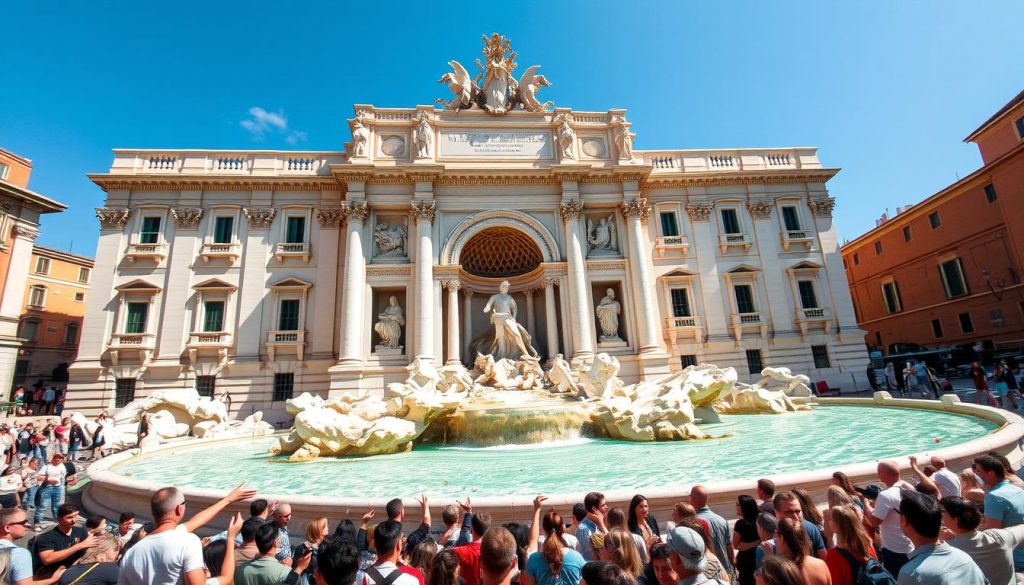Throwing Coins into Fountains: A Superstition for Good Fortune
The act of tossing coins into fountains is a captivating coin superstition that has lasted for centuries. It’s believed to bring good fortune to those who do it, hoping their wishes will come true. At famous spots like Rome’s Trevi Fountain, over $1 million in coins are thrown each year.
Anúncios
This tradition is found worldwide, from tossing coins into wells to fountains. It shows a deep desire for luck and success. People believe throwing one coin means they’ll return to Rome. Two coins might lead to love, and three could mean marriage.
The Origins of Coin Tossing in Fountains
The tradition of tossing coins into fountains has ancient roots. In Rome, Celtic tribes, and Nordic cultures, water was seen as a divine gift. People left water offerings to please gods and ensure water supply. This led to tossing coins into fountains for personal wishes.
At first, tossing coins helped ensure everyone had access to clean water. Over time, it became a way to ask for health, wealth, and love. Today, tossing coins into famous fountains is a popular tradition worldwide. It shows how ancient practices still influence us.
The Trevi Fountain in Rome is a prime example. Visitors toss coins for different reasons. One coin means they want to return to Rome. Two coins are for love, and three for all three: return, love, and marriage. This tradition connects the past with today, showing how old customs shape our actions.
Anúncios
As tourism grows, so does the tradition of coin tossing. It’s found in many cultures, showing a deep connection with water. It brings people together through shared hopes and dreams.
The Trevi Fountain: The World’s Most Famous Wishing Well
The Trevi Fountain in Rome is famous worldwide. It attracts both tourists and locals with its beauty and history. It took thirty years to build, from 1732 to 1762.
This fountain is 26.3 meters tall and 49.15 meters long. It shows off the grand style of Baroque architecture.
People visit the fountain for its beauty and the coin tossing ritual. Every day, about €3,000 is thrown in. This adds up to €1.1 million a year.
To toss a coin, you must turn your back to the fountain. Then, toss the coin over your left shoulder. It’s believed that one coin means you’ll return to Rome. Two coins bring new love, and three promise marriage.

The fountain’s water comes from the Aqua Virgo aqueduct. It’s 22 kilometers long and 13 kilometers from Rome. Every day, it uses over 2,824,800 cubic feet of water.
Keeping the fountain clean is a big job. It needs about 300,000 liters of water for each cleaning. This ensures it stays beautiful.
In 2013, a big restoration was done. It was funded by Fendi, an Italian fashion house. Now, over 100 LED lights light up the fountain at night. This makes it even more magical for visitors.
| Feature | Details |
|---|---|
| Height | 26.3 meters (86 feet) |
| Length | 49.15 meters (161.3 feet) |
| Annual Coin Toss | Approximately €1.1 million |
| Daily Average Toss | About €3,000 |
| Aqueduct Length | 22 kilometers (14 miles) |
| Daily Water Usage | More than 2,824,800 cubic feet |
| Restoration Cost (2013) | €2.2 million (approximately $2.4 million) |
| LED Lights Installed | Over 100 |
Coin Superstition: Cultural Beliefs Across the Globe
Coin superstitions are found in many cultures. In the United States, the silver dollar is seen as a lucky coin. It’s believed to bring good luck. In Ireland, carrying a single penny is thought to attract good fortune.
In China, coins tied with a red ribbon are lucky. The best lucky coins have an eternal knot. The lucky toad, Ch’an Chu, holds a coin in its mouth, showing coins can bring prosperity.
Many traditions involve coins. In the UK, finding a coin in Christmas pudding means prosperity. In Belgium, a coin under plates on New Year’s Eve brings luck. In Poland, washing your face with coins before December 24 ensures a prosperous year.
Rituals with coins vary. In Thailand, picking up a coin is important to avoid losing money. In Brittany, a coin was buried in new buildings for protection. People worldwide put coins in wallets or purses to attract wealth.
People everywhere give coins special meanings. In different places, putting a coin in a wallet is a ritual for financial stability. In Japan, white snakeskin purses are popular for good luck.
From the Czech Republic to South Africa, coins are loved for luck and prosperity. Each belief adds to the rich tapestry of coin superstitions. It shows how global superstition and human creativity keep these traditions alive.
| Country | Coin Superstition |
|---|---|
| United States | Silver dollars are deemed lucky |
| Ireland | Carrying a penny attracts fortune |
| China | Coins tied with a red ribbon symbolize luck |
| UK | Finding a coin in Christmas pudding brings prosperity |
| Argentina | Exchanging a coin prevents bad luck |
| Poland | Washing face with coins ensures prosperity |
| Belgium | A coin under plates on New Year’s Eve attracts luck |
| Japan | White snakeskin purses are believed to bring wealth |
The Ritual of Tossing Coins into Fountains
Throwing coins into fountains is a cherished ritual worldwide. People visit these water spots, filled with coins, hoping for good luck. They toss coins for wishes like health, happiness, or love.
The Trevi Fountain in Rome is famous for this coin tossing practice. Since 1762, visitors toss a Euro coin into the fountain. One coin means you’ll return to Rome, two for new love, and three for marriage. This shows how old myths and modern wishes blend.
Every year, the Trevi Fountain raises about €1.5 million for charity. This money helps the community, making the ritual meaningful. Millions visit, boosting Rome’s tourism.
In many places, you see similar rituals. They show a common bond. For example, in ancient China, coins were thrown into a pool to fund a temple for a year.
The Symbolism Behind the Coin Offerings
Coin offerings are more than just coin value. They are about hopes, dreams, and reaching out to divine forces. Tossing a coin is like investing in one’s future. Even small coins carry deep meanings.
This act shows devotion and adds value beyond just money. In the past, people used pins, buttons, and coins to seek health and fortune.
47% of people toss coins to make wishes. This tradition is found worldwide, showing a desire for divine help. In Europe, about 60% of people believe in the spiritual significance of coin tossing.
At the Trevi Fountain, over €1 million is collected each year. This money comes from offerings made by millions of visitors. Around 40% of these coins go to charity, showing the dual purpose of these offerings.
The symbolism of coin tossing has deep roots, going back over 2,000 years. Coins connect us to ancient rituals, adding depth to today’s practices. As cultures change, the importance of these offerings remains, symbolizing luck and connection to something greater.
| Coin Offering Statistics | Data |
|---|---|
| Annual growth rate of coin market (2018-2023) | 4.5% |
| Population engaging in coin tossing in Europe | 60% |
| Coins thrown daily at Trevi Fountain | 2,500 |
| Coins collected in Trevi Fountain annually | Over €1 million |
| Percentage of tourists believing in coin tossing luck | 73% |
| Participants who associate coins with lucky signs | 50% |
| Individuals who actively search for coins | 25% |
| Coins used for charitable causes | 40% |
Modern Practices and Their Evolution
The tradition of tossing coins into fountains has changed a lot today. It now mixes modern traditions with the evolution of practices from different cultures. In places like Southern California, people do this without knowing its history. They see it as a fun way to hope for the best.

Movies and popular culture have made tossing coins into fountains more meaningful. It’s a simple act that shows a deep wish for luck and a better future. When people do this, it connects them to the cultural significance of making wishes. It shows a timeless bond with others’ hopes and dreams.
Superstitions are still big in many cultures. Modern practices show how old beliefs still live on. People keep these rituals alive as a way to hold onto hope, especially when things get tough. It’s not just about personal wishes. It’s also about sharing moments with loved ones, bringing everyone closer together.
The history behind these modern traditions is quite interesting. It shows how old customs have changed but still hold value today. Tossing coins into fountains is a great example. It shows how history and today’s emotional needs can come together, spreading kindness and community in our changing world.
Why People Believe in Coin Superstitions
Belief in coin superstitions comes from human psychology and culture. Coins are seen as symbols of luck and wealth. This idea comes from ancient times when coins were tied to special practices.
Tossing a coin into a fountain lets people make wishes. It’s a way to connect with the unknown and feel in control. This simple act gives people a sense of power over their future.
At places like the Trevi Fountain, tossing coins is a shared tradition. About 80% of visitors join in, making it a community event. This shared experience strengthens the bond among those who participate.
Handling coins also has its own set of superstitions. For example, many avoid picking up pennies that are face-down, fearing bad luck. Keeping a purse off the ground is believed to ward off financial troubles. These superstitions show how our beliefs about objects influence our actions.
Coin superstitions are deeply rooted in culture, blending old and new traditions. From the lucky penny to wedding folklore, these beliefs bring people together. They help us navigate our hopes for good fortune.
Conclusion
Tossing coins into fountains is a fascinating look at humanity’s hopes and beliefs. It shows our desire for luck and fortune across cultures. This tradition connects us to our shared past and our wish for good luck.
This practice reveals a lot about our traditions and our minds. It shows how old superstitions still captivate us today. These simple acts touch our hearts deeply, showing the power of tradition.
Looking at coin tossing, we see more than just a fun activity. It’s a symbol of our search for hope in uncertain times. This tradition shows that believing in luck is a big part of being human. It makes coin tossing a timeless and universal part of our lives.
